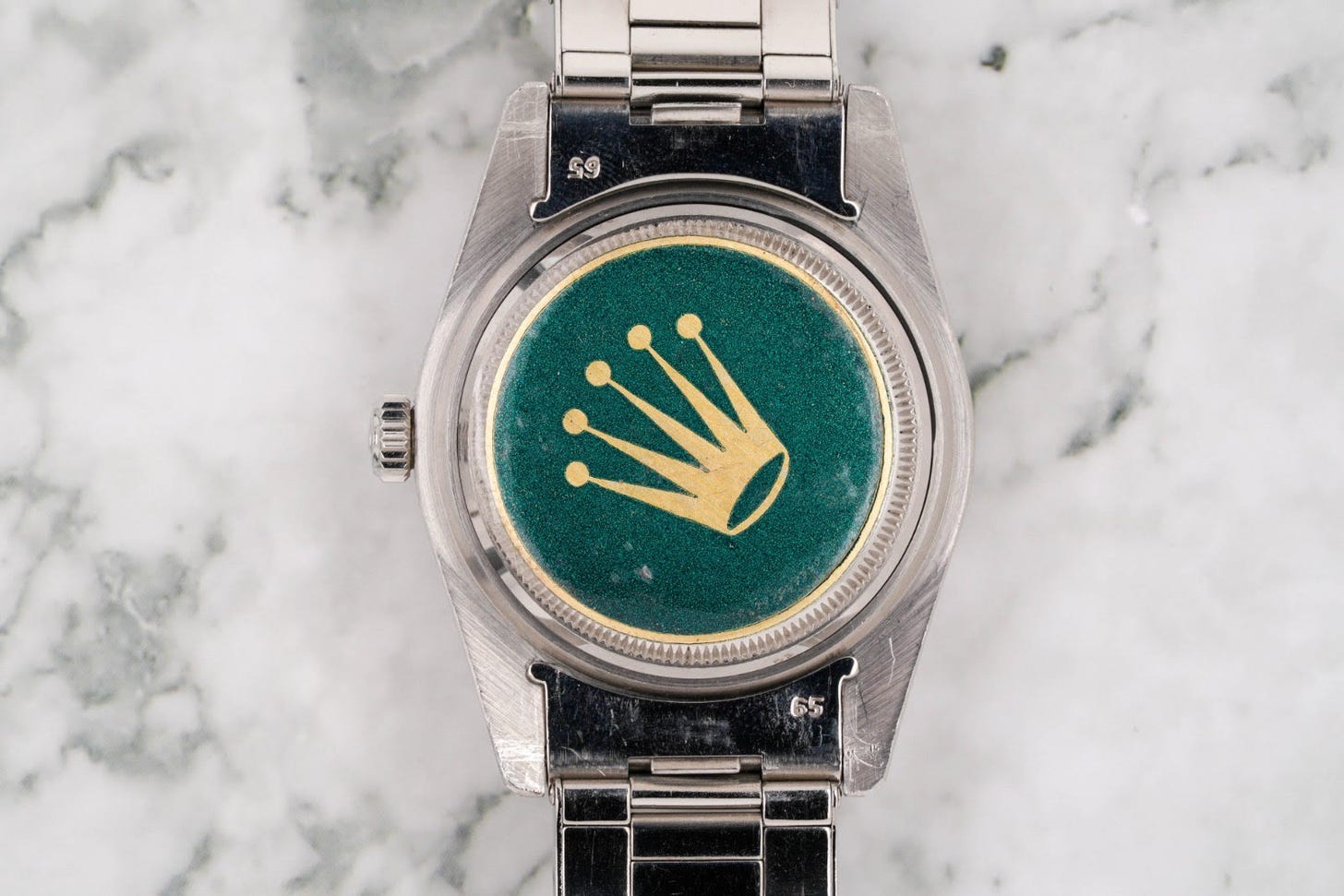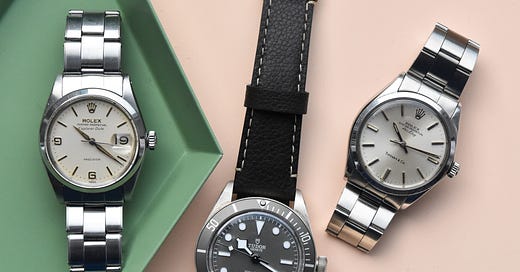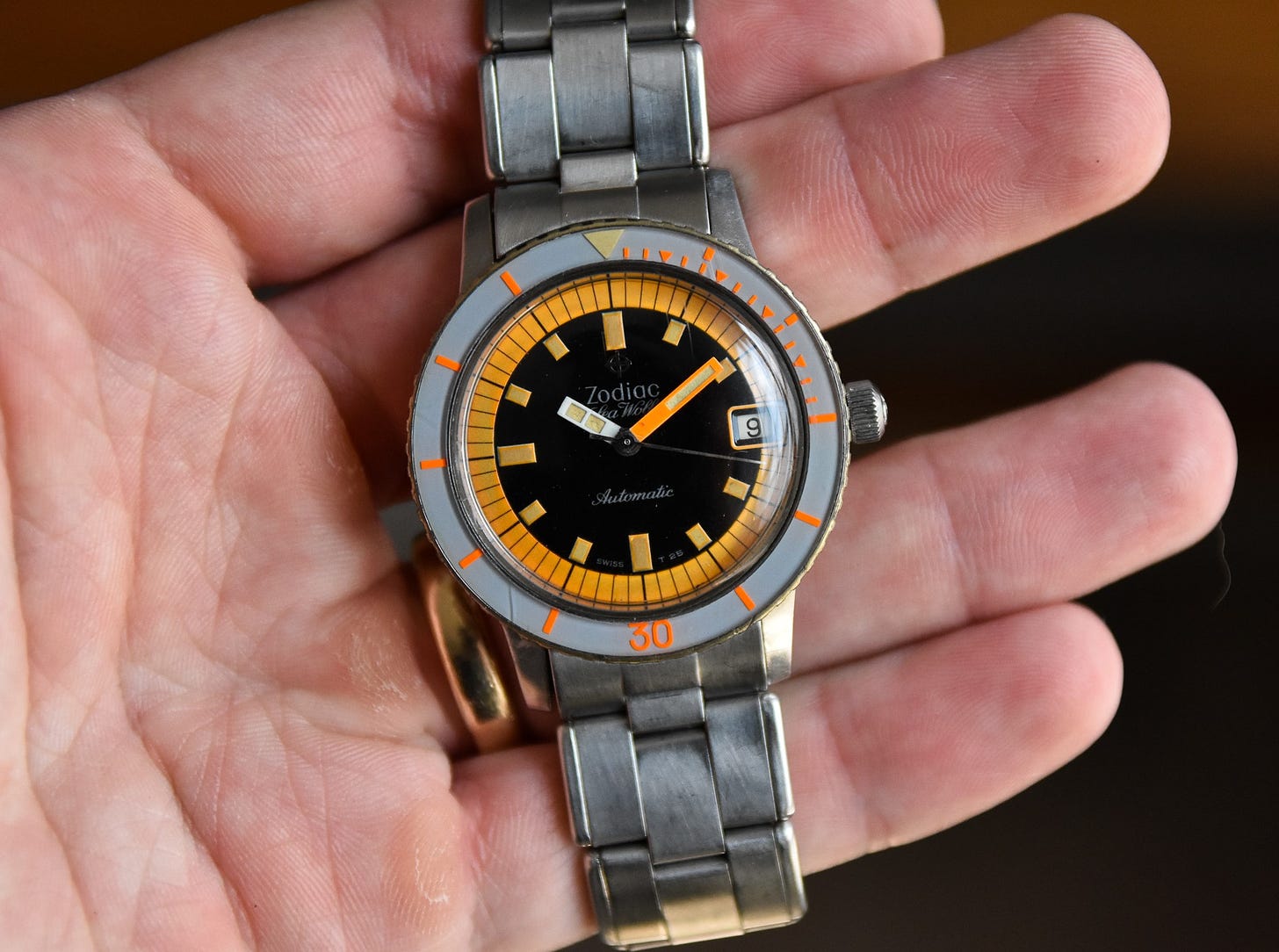How Rolex became the world's top luxury watch brand
Exploring caseback stickers; discovering the vintage Zodiac Sea Wolf
A jam-packed episode today: (1) How Rolex became the world’s top luxury watch brand; (2) exploring caseback stickers, what to do with them, and what they mean; (3) discovering the Zodiac Sea Wolf, the forgotten vintage dive watch. Rescapement is a weekly newsletter about watches. To get it delivered straight to your inbox every weekend, subscribe now:
Seriously? An article about caseback stickers?
By: Charlie Dunne
The array of nifty things to geek out over within watches is seemingly endless. These can come in the form of an original strap, period-correct buckles or bracelets, hang tags, or the most adorned, original box and papers. But perhaps the most impractical (and unimpressive) of all is the caseback sticker.
While it’s fair to assume that most collectors wouldn’t turn their nose up to an immaculately preserved watch, the caseback sticker is really one of those attributes that doesn’t make a watch any more impressive. Some collectors may even be faced with the internal struggle of preserving the sticker at the cost of not wearing the watch. Quite frankly, it seems much easier to relegate a watch to the drawer as opposed to checking the forecast before slapping the watch to the wrist. Or even worse, putting some protective adhesive layer over the sticker. Where is the fun in that? A sticker to protect a sticker?
Although some may find the protective coating on their casebacks to be a worthwhile measure for military or personal engravings, the application on top of a caseback sticker will most likely expedite its deterioration. So for those eager for the subtle flex via flipping the watch over, hold off on that urge.

The piece concludes with a few takeaways:
At the end of the day, is there a superior school of thought when it comes to watches with their caseback stickers? Stein offered some noteworthy points to the counterargument. “I believe that these types of ephemera can add value to a watch. In the world of vintage Heuer chronographs, the ‘full set’ is not as ‘full’ as with some other brands; in other words, we don't see the same types of papers as with some other brands. But having the original box, the instruction booklet and the store receipt is a big plus for a vintage Heuer chronograph. Again, I put the sticker pretty low on the list, as they will deteriorate if left on while the watch is worn. Basically, anything that connects the watch to the moment when it was sold, even a story from the original owner or their family, will add value.”
👉 Check out the full article, with more great insights from Menta Watches, Jeff Stein, and Charlie himself.
The forgotten dive watch: Finding my grail Zodiac Sea Wolf
By: Max Braun
Members of the watch community often refer to the Rolex Submariner or the Blancpain Fifty Fathoms as the first purpose-built dive watches available to the public. What I don’t usually hear is that there was a third dive watch released to the public in 1953, which was announced at Basel Fair alongside the Fifty Fathoms. The brand was Zodiac, and the watch, a Zodiac Sea Wolf. Put yourself in the shoes of a consumer in 1953 reviewing these new dive timers. A Submariner? Okay, the thing goes underwater. A Fifty Fathoms? Okay, the watch can survive up to ~90 meters. A Sea Wolf? A few seconds of tossing that name around in your head can yield only one result: a “sea wolf” is definitely not a thing and this makes no sense. Mr. Salesman, one Submariner for me please.
When Zodiac released its Sea Wolf at the 1953 Basel Fair, it was the first dive watch, alongside the Fifty Fathoms, to feature a rotating bezel. And with a depth rating of 10 atmospheres (~100 meters), it was actually green lit to go slightly deeper than the Fifty Fathoms (~90 meters). The rest of the story you probably know. The Sub goes on to become the gift du jour for well-heeled, male college grads while the Fifty Fathoms would become a favorite for the inside baseball crowd. And somewhere along the way, we forgot about the Sea Wolf.
But the Zodiac Sea Wolf is so much more than a vintage watch with a funny name.
👉 Check out the full article here.
How Rolex became the world’s top luxury watch brand
It’s always interesting to see how the mainstream media covers the watch industry, observing it from the ivory tower that houses the enlightened consumers of this very ‘sletter.
Lately, the reporting has focused on the twin phenomena of Rolex’s (and Patek’s) un-getability, combined with how it could’ve gotten that way (it’s all very circular and reinforcing).
As we’ve no doubt chronicled in these pages before, it’s got something to do with Rolex pivoting from a maker of tool watches to a maker of luxury watches sometime after the quartz crisis began in 1970. Business Insider adds some, well, inside info to explain how this all happened:
“When [Rolex founder Hans] Wilsdorf died in 1960, he was succeeded by Rolex's marketing director, André Heiniger, who spearheaded the decades-long effort to secure the brand's synonymity with luxury.
‘Rolex,’ Heiniger reportedly said, ‘is not in the watch business. We are in the luxury business.’”
From then on, Rolex went scorched earth with advertising, snagging movie placements, sponsoring every sports event on the planet, Roger Federer. The article also explores the impact of Italian collectors in creating the vintage Rolex market. But the point is Rolex became a well-oiled advertising machine, creating the perception that it was the thing to have when you made it.
And there’s nothing wrong with that. Rolex clearly has a sh/t ton of money to invest in product and R&D too, so I don’t want to draw a false dichotomy. Innovations like its chronergy escapement are true steps forward for modern mechanical watchmaking. But it’s just a different business from being the maker of moderately-priced tool watches it was in the mid-20th century.
I was talking to the founder of Glasgow-based AnOrdain this week for another project, and he emphasized the fact that his company spends nothing on advertising and marketing. Everything goes into workshops, machinery, people, training, etc. Investing in the product, in other words. And that’s why AnOrdain is totally disrupting the market for enamel dials and creating one of the most exciting products in all of watches, regardless of price point.
Listen, I love a good marketing campaign as much as the next capitalist, but at the end of the day, it’s the watches that keep me coming back. The brands that I find most interesting are the ones trying new things, investing in their product and people.
If Rolex became the “world’s top luxury watch brand” by investing in product, as Business Insider suggests, no doubt the next great luxury watch brand is doing the same today.
Okay, enough business speak for the day, back to my Gary Vee podcasts.
👉 Check out the full report here.
Through the Wire
😍 ACL’s Michael Williams on 5 great watches.🔻 A retrospective on shaped watches. At 9k+ words, it’s everything you could ever want to know about the history of shaped watches (there’s even input from our own Charlie Dunne). 🎬 Recommended Watching: A New Film Exploring Why We're So Obsessed with Watches, featuring Daniel Dae Kim and Eric Wind. 📸 Always love a good photo report, this one of a bunch of watches and cars from Pebble Beach. 🖐 I NEED THIS CARTIER MITTEN WATCH.
Thanks for reading, as always.
-Tony
Rescapement is an independent weekly newsletter about watches, mostly vintage. Subscribe now to get it delivered to your inbox every Sunday.







